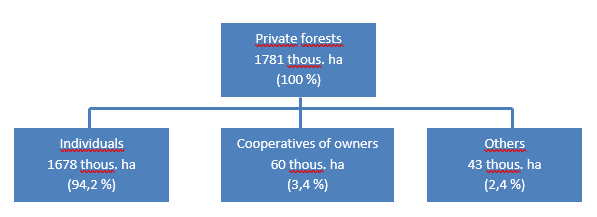Private forests
On the territory of Poland 94,2% of private forests are the property of individual persons. A relatively substantial part of privately-owned forests is owned by land communes (about 3%). The remaining part, i.e. private forest belonging to farming cooperatives, churches, religious associations, trade unions and others, occupies a comparatively small area.

Private forests are spread unevenly over the area of Poland, obviously due to the impact of our history. Forest of individual private ownership have the smallest share in the total forest area in the territory of the so-called Reclaimed Lands, and partly in the lands formerly annexed by Prussia as well as in the area covered by the Military Operation ‘Wisła’ in the south-east Poland. On the other hand, in the areas of Podlasie and Lubelszczyzna the share of private forests is substantial: the biggest share of private forests amounting 70% is in the east, where the former minor properties of the nobility and ‘zaścianki’ were located, namely in the Wysokie Mazowieckie county (79%), Siedlce (73%) and Sokołów (70%), and in the Carpathian foothills of the Małopolska region in the Myślenickie county (71%). In 215 out of 314 land counties, the share of private property in the total forest area accounts for less than 30%. In 32 counties this share exceeds 50%.
Total area of private forests - as of January 1, 2024 - amounted to 1,780 thousand hectares; the standing volume was 487 million m3 and the average age of stands was about 55 years. The average standing volume amounted to 273 m3 per hectare of the forest area.
Since there are few reliable data sources, the principal felling management tasks were estimated basing only on the data on final felling and pre-final felling in private forests included in the National Forest Inventory and accounted for about 2.9 million m3 gross annually, which comprised:
- 0.8 million m3 of merchantable timber in final felling,
- 2.1 million m3 of merchantable timber in pre-final felling.
In private forests, the dominant forest habitat type are lowland habitats of mixed forests.
The dominant species with the highest share in private forests are: pine (58.4%), alder (8.4%) and fir (6.8%).
Local authority-owned forests
Total area of local authority-owned forests - as of January 1, 2024 - amounted to 84 thousand hectares; the standing volume was 34 thousand m3 and the average age of stands was about 85 years. The average standing volume amounted to 400 m3 per hectare of the forest area.
Since there are few reliable data sources, the principal felling management tasks were estimated basing only on the data on final felling and pre-final felling in local authority-owned forests included in the National Forest Inventory and accounted for about 236 thousand m3 gross annually, which comprised:
- 116 thousand m3 of merchantable timber in final felling,
- 120 thousand m3 of merchantable timber in pre-final felling.
The greatest number of local authority-owned forests occur in lowland mixed forest habitats.
The dominant species with the highest share in local authority-owned forests are: pine (37.2%), beech (14.3%) and fir (10.8%).
Forests in the Agricultural Property Stock of the Treasury
Total area of forests in the Agricultural Property Stock of the Treasury - as of January 1, 2024 - amounted to 28 thousand hectares; the standing volume was 8 thousand m3 and the average age of stands was about 60 years. The average standing volume amounted to 290 m3 per hectare of the forest area.
Since there are few reliable data sources, the principal felling management tasks were estimated basing only on the data on final felling and pre-final felling in forests in the Agricultural Property Stock of the Treasury included in the National Forest Inventory and accounted for about 27 thousand m3 gross annually, which comprised:
- 1 thousand m3 of merchantable timber in final felling,
- 26 thousand m3 of merchantable timber in pre-final felling.
In forests in the Agricultural Property Stock of the Treasury, the dominant forest habitat type are lowland forest habitats.
The dominant species with the highest share in forests in the Agricultural Property Stock of the Treasury are: alder (32.6%), pine (17.3%) and oak (12.9%).
Forests under National Park management
Total area of forests under National Park management - as of January 1, 2024 - amounted to 188 thousand hectares; the standing volume was 76 thousand m3 and the average age of stands was about 87 years. The average standing volume amounted to 404 m3 per hectare of the forest area.
Since there are few reliable data sources, the principal felling management tasks were estimated basing only on the data on final felling and pre-final felling in forests in the Agricultural Property Stock of the Treasury included in the National Forest Inventory and accounted for about 94 thousand m3 gross annually, which comprised:
- 13 thousand m3 of merchantable timber in final felling,
- 81 thousand m3 of merchantable timber in pre-final felling.
The greatest number of forests under National Park management occur in the habitats of mountain forests.
The dominant species with the highest share in forests under National Park management are: beech (31.6%), pine (31.3%), and spruce (10.9%).
Other State Treasury Forests
Total area of other Treasury-owned forests - as of January 1, 2024 - amounted to 59 thousand hectares; the standing volume was 18 thousand m3 and the average age of stands was about 67 years. The average standing volume amounted to 316 m3 per hectare of the forest area.
Since there are few reliable data sources, the principal felling management tasks were estimated basing only on the data on final felling and pre-final felling in other Treasury-owned forests included in the National Forest Inventory and accounted for about 126 thousand m3 gross annually, which comprised:
- 50 thousand m3 of merchantable timber in final felling,
- 76 thousand m3 of merchantable timber in pre-final felling.
According to CSO Forestry 2024, National Forest Inventory (2020-2024)

